Both Companies Report Weak Orders & Deliveries – 737 MAX Technical Review to Release Observations, Findings, and Recommendations Soon.
by J. Kasper Oestergaard, European Correspondent, Forecast International.
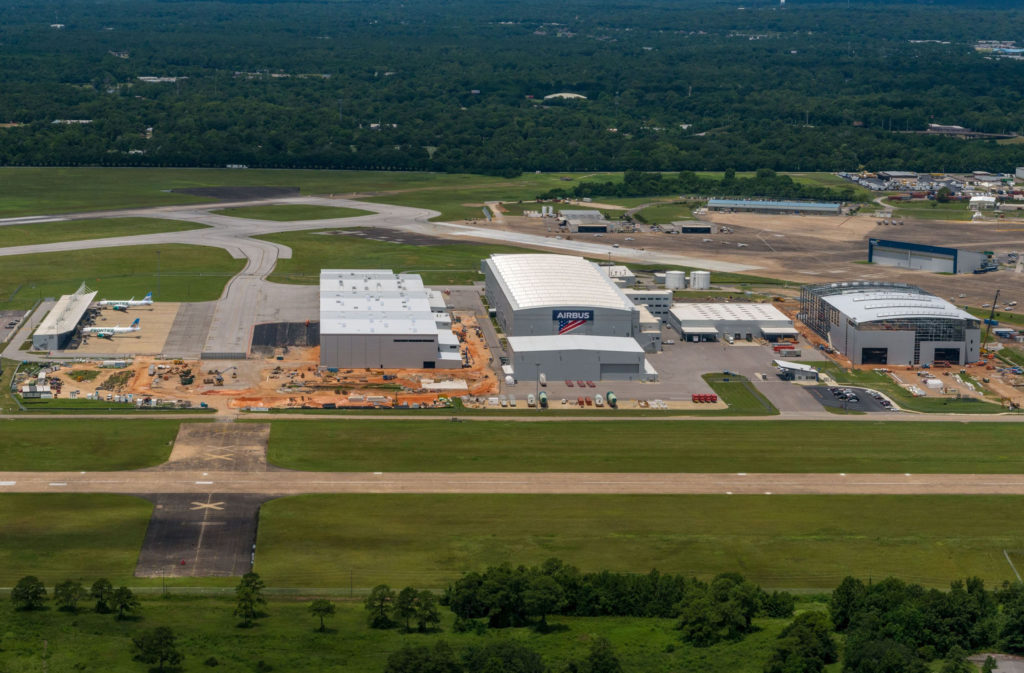
Boeing and Airbus delivered 18 and 42 commercial jets in August 2019, compared to 64 and 54 deliveries, respectively, in the same month last year. Airbus gave no explanation as to why its deliveries dropped substantially in August. With just 276 deliveries this year to date, Boeing is 205 shipments behind last year’s total for the first eight months of the year. Airbus delivered a total of 500 jets from January to August, compared to 434 during the same period last year. Boeing’s deliveries have taken a severe hit since the March 10 crash of Ethiopian Airlines Flight 302, a 737 MAX, and the subsequent deliveries halt and grounding of the fleet. Boeing decided on March 14 to suspend all deliveries of 737 MAX jets. The crashes were with a high degree of certainty caused by the aircraft’s Maneuvering Characteristics Augmentation System (MCAS), which suddenly activated in response to erroneous angle of attack information. In 2018, Boeing delivered 806 jets (763 in 2017), with Airbus handing over 800 (718 in 2017).
In August, Boeing delivered a single 737 NG. Boeing is still producing 737 MAX jets at a reduced rate of 42 aircraft per month and thereby building up an inventory of aircraft ready to be shipped. During 2018, Boeing raised its 737 production rate to 52 and was planning a further increase to 57 per month from June of this year. Producing the 737 MAX at a reduced rate will allow the company to prioritize additional resources to focus on returning the 737 MAX to flight.
In April, the U.S. Federal Aviation Administration (FAA) established a Boeing 737 MAX Joint Authorities Technical Review (JATR) comprising a team of experts from the FAA, NASA, and international aviation authorities. Since then, Boeing has worked with the FAA, and the JATR and has tested updates to its 737 MAX software during hundreds of flights. On August 5, Boeing CEO Dennis Muilenburg announced that the company has conducted almost 500 737 MAX test flights with updated software. According to the Associated Press, Boeing is currently working on new software for the 737 MAX that will use a second flight control computer to make the system more reliable. On August 30, the FAA announced that the JATR is taking additional time to finish documenting its work. The panel is expected to submit its observations, findings, and recommendations in the coming weeks.
In early September, Muilenburg announced that the 737 MAX could be brought back into service gradually by government regulators and that the aircraft is still on track to be cleared to fly again in 2019. Exactly when the 737 MAX will return to service remains unclear, however. Boeing’s best estimate is that the jet could be approved “early in the fourth quarter.” The largest operator of the grounded jet, Southwest Airlines, has canceled all 737 MAX flights through early January. In total, Boeing has delivered 387 737 MAX jets to date. A total of 256 737 MAX jets were delivered in 2018, up from 74 in 2017. In August, Boeing also delivered three 767s, three 777s and 11 787s. Boeing recently raised the monthly Dreamliner production rate to 14 aircraft. Boeing has handed over 101 787s year-to-date. The company delivered 145 787s in 2018, up from 136 in 2017. In connection with Boeing’s second quarter 2019 earnings report, Muilenburg announced that Boeing plans to increase 777F production due to 777X delays, but did not disclose by how much.
In August, Airbus delivered three A220s, 28 A320s (9 CEO / 19 NEO), six A330s, and five A350s. Later this year, Airbus expects to increase the A320 production rate to 60 aircraft per month. Furthermore, the company is targeting a raise to 63 jets per month from 2021. A total of 386 A320neo family aircraft were delivered in 2018, up from 181 and 68 in 2017 and 2016, respectively. Airbus has shipped off 65 A350s year-to-date, having delivered 93 A350s in 2018, up from 78 in 2017, and recently increased the monthly production rate to 10. Airbus is considering a further increase to 13 A350s per month, but a date has yet to be announced. With the ramp-up of A350 XWB deliveries combined with a higher A320 production rate, Airbus has nearly eliminated Boeing’s deliveries lead in recent years. Following the tragic 737 MAX events, Airbus is now almost certain to deliver more aircraft in 2019 than Boeing.
Turning to the orders race, Boeing had a very quiet month in August, logging just six gross orders, all for 777 and 787 widebody jets (three cancellations => net of three). Boeing’s August bookings included three 777Fs for China Airlines, two 787-9s for a business jet / VIP customer, and one 777-200LR for Turkmenistan Airlines. Year-to-date, Boeing has accumulated 145 gross orders (230 cancellations => -85 net new orders). For full-year 2018, Boeing booked 893 net new orders (1,008 gross orders).

Airbus also had a quiet month and booked just 16 gross orders, but reported no cancellations. In August, an undisclosed customer ordered 15 A321XLRneos and a private customer ordered a single ACJ320neo. For 2019 to date, Airbus reports 262 gross orders (167 cancellations => net of 95). Of these cancellations, 31 were due to Emirates’ decision earlier this year to reduce its A380 order book. This subsequently forced Airbus to announce that it will cease A380 production in 2021. In 2018, Airbus landed a total of 747 net new orders (831 gross orders), thereby losing the 2018 orders race as Boeing had accumulated 893 net new orders. Airbus had retained an orders lead over its rival every year since 2012.
On August 31, 2019, Airbus’ backlog was 7,172 jets, of which 6,238, or 87 percent, are A220 and A320ceo/neo family narrowbodies. The company’s all-time backlog record high of 7,577 jets was set in December 2018. By the end of August 2019, Boeing’s backlog (total unfilled orders after ASC 606 adjustments) was 5,730 aircraft, of which 4,595, or 80 percent, are 737 NG/MAX narrowbody jets. Boeing’s all-time backlog high of 5,964 aircraft was set in August 2018. The number of Airbus aircraft to be built and delivered represents 9.0 years of shipments at the 2018 production level. In comparison, Boeing’s backlog would “only” last 7.1 years. This year to date, Boeing’s book-to-bill ratio, calculated as orders divided by deliveries, is negative. Airbus’ book-to-bill ratio is 0.19. In 2018, Boeing boasted a book-to-bill ratio of 1.11, with Airbus at 0.93. In 2017, Boeing booked 912 net new orders for a book-to-bill ratio of 1.20. That same year, Airbus booked 1,109 net new orders, for a book-to-bill ratio of 1.54.
2019 Forecast
Forecast International’s Platinum Forecast System® is a breakthrough in forecasting technology. Among many other features, Platinum provides 15-year production forecasts. The author has used the Platinum Forecast System to retrieve the latest delivery forecasts and, for 2019, Forecast International’s analysts expect Boeing and Airbus to deliver 724 and 875 large commercial jets, respectively. The 2019 forecast for Boeing was 904 prior to the second 737 MAX crash and the subsequent grounding of the fleet and temporary cut in the production rate. These are the latest “live” forecast figures (adjusted frequently by FI analysts as new information comes in). These figures exclude militarized variants of commercial platforms such as Boeing’s P-8 Poseidon, KC-46 and KC-767 tankers, and C-40; and Airbus’ A330 MRTT tanker.
Prior to the second 737 MAX crash, Boeing announced, in connection with the release of its 2018 earnings report in late January, that it was targeting between 895 and 905 commercial jet deliveries in 2019, a 12-13 percent increase from 2018. Boeing has yet to announce a revised figure and is likely awaiting the 737 MAX’s return to service before providing updated guidance. On February 14, Airbus announced that it is aiming for 880 to 890 commercial aircraft deliveries in 2019, equal to a 10-11 percent increase from 2018.
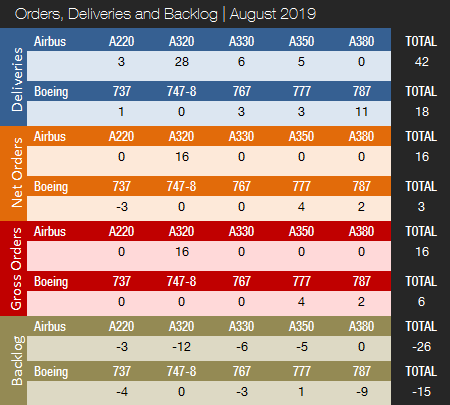
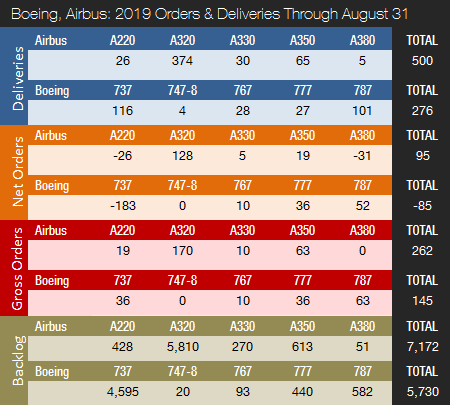
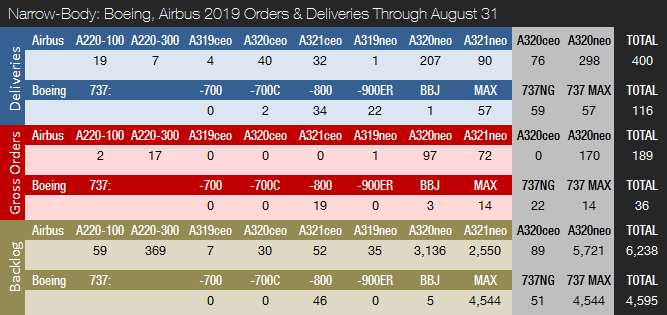
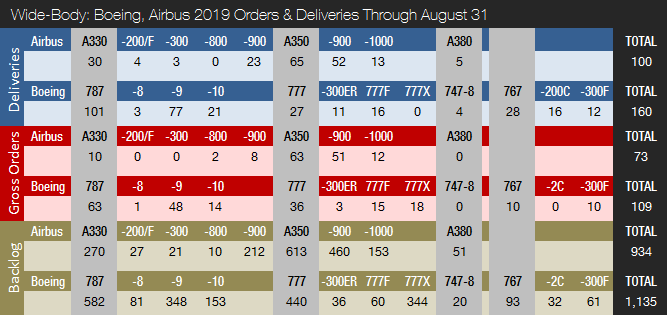
Note: Boeing 777-300ER orders include one 777-200LR. The 777-300ER backlog includes two 777-200LRs.
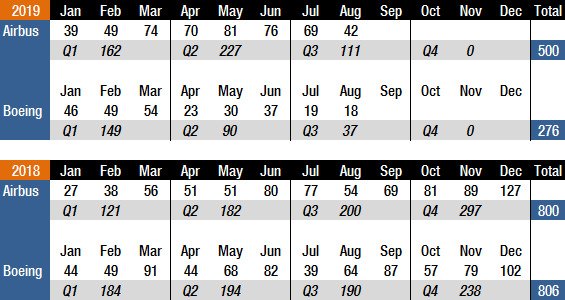

Joakim Kasper Oestergaard is Forecast International’s AeroWeb and PowerWeb Webmaster and European Editor. In 2008, he came up with the idea for what would eventually evolve into AeroWeb. Mr. Oestergaard is an expert in aerospace & defense market intelligence, fuel efficiency in civil aviation, defense spending and defense programs. He has an affiliation with Terma Aerostructures A/S in Denmark – a leading manufacturer of composite and metal aerostructures for the F-35 Lightning II. Mr. Oestergaard has a Master’s Degree in Finance and International Business from the Aarhus School of Business – Aarhus University in Denmark.
References:
- http://www.boeing.com/commercial/#/orders-deliveries
- https://www.airbus.com/aircraft/market/orders-deliveries.html
- https://www.faa.gov/news/updates/?newsId=93206
- https://www.boeing.com/commercial/737max/737-max-update.page
- https://www.airbus.com/newsroom/press-releases/en/2019/08/airbus-begins-us-production-of-a220-aircraft.html
- https://www.businesstraveller.com/business-travel/2019/08/27/southwest-extends-b737-max-cancellations-into-2020/
- https://eu.usatoday.com/story/news/nation/2019/08/21/boeing-max-737-faa-to-hear-findings-certification/2062753001/
- https://news.yahoo.com/boeing-ceo-737-max-could-phased-back-regulators-162621707.html
A military history enthusiast, Richard began at Forecast International as editor of the World Weapons Weekly newsletter. As the Internet grew in importance as a research tool, he helped design the company's Forecast Intelligence Center and currently coordinates the EMarket Alert newsletters for clients. Richard also manages social media efforts, including two new blogs: Defense & Security Monitor, covering defense systems and international issues, and Flight Plan, which focuses on commercial aviation and space systems. For over 30 years, Richard has authored the Defense & Aerospace Companies, Volume I (North America) and Volume II (International) services. The two books provide detailed data on major aerospace and defense contractors. He also edits the International Contractors service, a database that tracks all the contractors involved in the programs covered in the FI library. More recently he was appointed Manager, Information Services Group (ISG), a new unit that encompasses developing outbound content for both Forecast International and Military Periscope.




